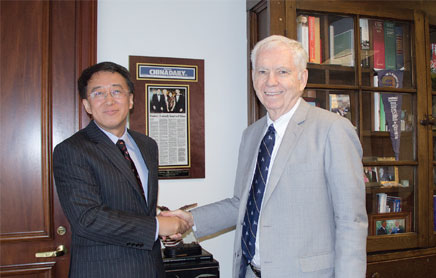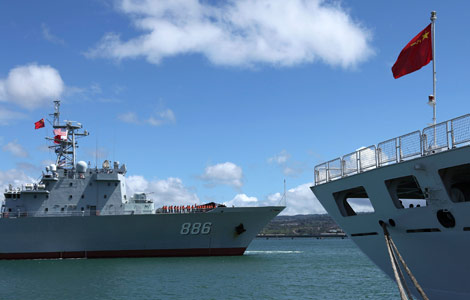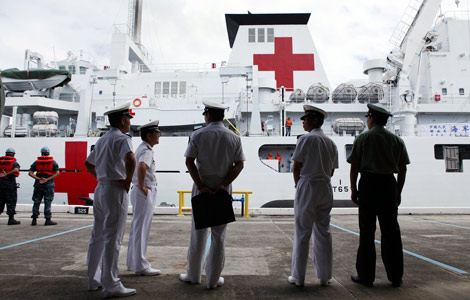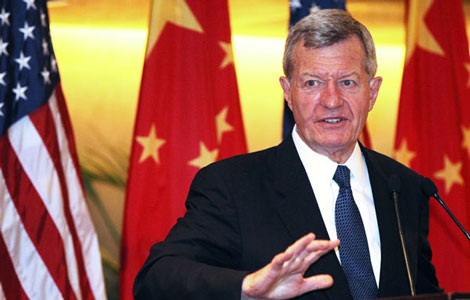RIMPAC launches, with China
Updated: 2014-06-27 11:12
By Chen Weihua in Washington and Zhao Shengnan in Beijing (China Daily USA)
|
||||||||
Fleet includes 47 ships, 6 subs and 25,000 sailors from 22 nations
The Rim of the Pacific Exercise, or RIMPAC, the world's largest naval war games, began on Thursday in and around the Hawaiian Islands with China participating for the first time.
Ships taking part in the international group sailed to Hawaii ahead of the exercises, including vessels from the US, Brunei, Singapore and four from the Chinese People's Liberation Army Navy: missile destroyer Haikou, missile frigate Yueyang, supply ship Qiandaohu and hospital ship Peace Ark, according to the Pentagon.
The Chinese ships, with 1,100 sailors, arrived in Hawaii on Tuesday. The fleet is second in size only to the host nation, the United States.
RIMPAC 2014 is the 24th such exercise since it was launched in 1971 and has been held biennially ever since. Besides China, Brunei and Norway are also participating for the first time.
The drills this year, hosted by the US Pacific Fleet, involve 47 ships, six submarines, more than 200 aircraft and 25,000 sailors. The 23 original nations participating were down to 22 after Thailand was refused participation on Wednesday following a US State Department decision in response to a May 22 military coup in the Asian nation, the Honolulu Star Advertiser reported.
During the drills, forces from China, the US, France, Mexico and Brunei will jointly conduct weapons firing, supply transportation, damage control, anti-piracy and disaster relief drills, as well as coordinated interceptions and landings and joint assaults by warships and helicopters.
Chinese sailors participate in exchanges from June 25 to July 8, including press conferences, visits of warships, basketball and football matches and a 5-kilometer cross-country race.
China's Ministry of National Defense spokesman Yang Yujun said in Beijing on Thursday that China sent several advanced vessels to help forge a new era in the Sino-US military relationship.
Yang said the two countries have shared interests but face differences, and China believes they should work together to strengthen communication and handle those differences.
"The multinational group sail has provided a wonderful opportunity to establish working and personal relationship with the navies from Brunei, China and Singapore in preparation for RIMPAC," Captain Patrick Kelly, commanding officer of the guided-missile cruiser USS Chosin who led the sail from Guam to Hawaii, was quoted on a Pentagon website.
Zhang Junshe, a naval expert at PLA Naval Military Studies Research Institute, said by displaying its core force, China has a good opportunity to demonstrate its transparent military policy and determination to maintain peace.
The exercises, which will last until August 1, come at a time when bilateral relations between China and the US have soured following the growing tensions in both the East and South China seas in the past year as well as the indictment of five PLA officers by the US Justice Department a month ago for alleged cyber theft of US corporate secrets.
However, bilateral military exchanges have increased dramatically over the past two years, especially following the informal summit between Chinese President Xi Jinping and US President Barack Obama last June in Sunnylands, California. Top military officials from both sides, including Chinese Defense Minister Chang Wanquan and US Defense Secretary Chuck Hagel, have exchanged visits in the past year.
US Assistant Secretary for East Asian and Pacific Affairs Daniel Russel said the US is committed to building a sustained and substantive military-to-military relationship with China that focuses on identifying concrete, practical areas of cooperation and reducing risk.
But at the same time, the US will continue to carefully monitor China's military development and encourage China to exhibit greater transparency in its military spending and modernization, Russel told a hearing at the Senate Foreign Relations Committee on Wednesday.
China has repeatedly stated that its military spending is defensive in nature. China has also expressed its concerns over continued US arms sales to Taiwan, surveillance off the Chinese coast and US laws that restrict military exchanges with China as major obstacles for growing military-to-military relations.
Douglas Spelman, a senior advisor at the Kissinger Institute on China and the United States of the Wilson Center, agreed that US military surveillance off the Chinese coast was "provocative".
Contact the writers at chenweihua@chinadailyusa.com, and zhaoshengnan@chinadaily.com.cn.
|
The Chinese People's Liberation Army (PLA) Navy replenishment ship Qiandaohu (866) (left) sails past the PLA Navy hospital ship Peace Ark as it docks at the Joint Base Pearl Harbor Hickam to participate in the multi-national military exercise RIMPAC 2014, in Honolulu, Hawaii on Tuesday. RIMPAC is the world's largest biennial naval exercise between the US and Pacific Rim nations, with 23 countries participating this year, including China who is joining it for the first time. Hugh Gentry / Reuters |
(China Daily USA 06/27/2014 page1)
- Illegal drugs go up in smoke in Guangdong
- PLA vessels join Pacific naval drill for the first time
- Relatives unmoved by new search zone for jet
- Hebei envisions integrated traffic network by 2020
- 3D paintings entertain people in Hong Kong
- Officials deny planning to turn 600 colleges into senior vocational schools
Most Viewed
Editor's Picks

|

|

|

|

|

|
Today's Top News
Alibaba picks NYSE for IPO
50 trapped Chinese flown to Baghdad by helicopter
Analyst: GM recall unlikely to affect China
Status symbol loses its NY status
Alibaba plans to list shares on NYSE
Top hospitals abroad target nation's rich
PLA vessels join Pacific naval drill for the first time
Pentagrams on tower of babel
US Weekly

|

|
















